Your team are not mind readers. If you want your team to perform well, you have to give feedback to them regularly. If they don't know your standards or expectations, it's very unlikely they'll meet them consistently.
Unfortunately, the most common way managers give feedback is something crudely called the sh*t sandwich. Put simply: Before you give the critical feedback, you open with something positive about them. Then, after giving the critical feedback, you again say something positive. Hence the sandwich metaphor:
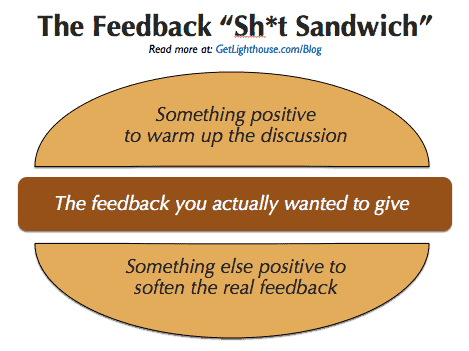
While the intentions may be good (don't hurt your team member's feelings), more often than not it comes off as pandering. It can also water down the important feedback in the middle of the sandwich, making it less effective.
So what should you do instead? Today, we have 6 ways to give feedback that beats the sh*t sandwich.
6 Ways to Give Feedback to Your Team to Improve Them
In the right situation, each of these methods of giving feedback can help you improve the performance of your team. Use your best judgment to decide when and how to apply each of these to your team.
The 6 approaches to give feedback to your team to improve their performance include:
- The 5 Word Review
- The Feed Forward
- Your One on Ones
- The Prepare - Listen - Act Model
- Trade Praise for Feedback
- Ask the Right Questions
Read through each of them and file them away. They all have unique value and can be used in different situations. And best of all, by having multiple ways to give feedback, your team will never grow bored of how you deliver it.

1) Give them a 5 Word Review
While the traditional performance review is often a moment of dread, the 5 Word Review, as coined by Kayak.com CEO Paul English, is an efficient, simple way to give feedback.
Here's how it works:
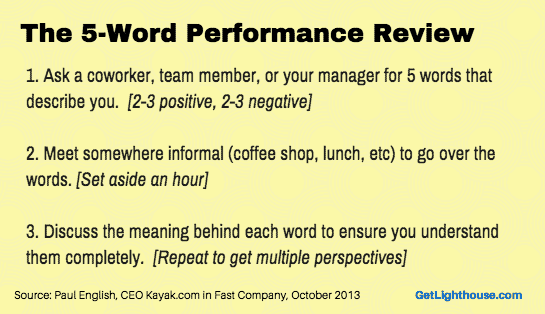
There's a few keys that make this method to give feedback really work well:
Genuine:
- The positive words are not there to rush through like the bread of the sh*t sandwich. They're actually highlighting something you like about them and their work. You should spend just as much time talking about the words you want to see more of, as any constructively critical words.
Meaningful:
- By setting aside an hour to dive into these 5 words, you ensure your team member takes real meaning away from your feedback.
Thematic:
- When you're limited to only a single word for each aspect of your feedback, it forces you to zoom out and look at high level trends: what do they consistently do well, or come up short on? Those are the most important things to highlight so they continue the good, and fix the chronically bad issues.
Given the simplicity of the 5 Word Review, it's easy to do at any time of year. Consider it a great way to give feedback to your team members as you notice trends in their work and behavior. Don't be afraid to ask them for a 5 word review, too.
2) Try a Feed Forward
A key part of feedback is that it's looking backward. What happened in the past, good or bad?
The power of Feed Forward is that it looks ahead. They're "positive suggestions for the future" as described in this awesome, quick video:
The rules of Feed Forwards are very straight forward:
- Rule #1: No feedback about the past.
- Rule #2: No judging or critiquing ideas.
Those rules are followed by a simple process:

Those simple steps are totally different than your usual ways to give feedback:
Ego-less:
- Focusing on what they've done before can lead to defensiveness and bruise their ego. Instead, Feed Forwards have the advantage of looking at ways to have a better future. It trades judgment on the past for optimism for the future.
Collaborative:
- Feedback can often be a one sided conversation: A manager tells a team member what they need to do differently. With Feed Forward, you can involve the whole team, tapping into their many experiences and ideas that can lead to improvement.
Actionable:
- It's easy for feedback to feel critical about things you can't control; the problem already happened and you can't change the past. By definition, all of the takeaways from Feed Forwards are things you can take action on: the future is not set.
Feed Forwards break the mold of the traditional feedback process. They're a great way to engage your team in helping each other improve. For more ideas on adapting Feed Forwards to your team, you can learn how the startup Tint used them here.
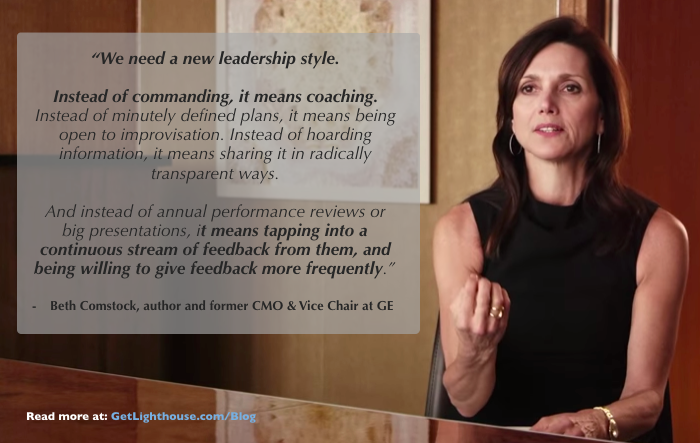
3) Use your One on Ones for feedback
While the world moves many things to real-time, feedback should sometimes wait. While egregious issues (harassment, blatant values violations, etc) should be handled immediately, many other situations are better left addressed after some reflection.
In How To Win Friends and Influence People, Dale Carnegie shares a story about Abraham Lincoln that captures this lesson well.
Lincoln would write letters to those that he had strong feedback for (like failed Civil War generals) while he was outraged. Rather than letting the heat of the moment get the best of him, he would not send these letters.
Instead, he would stash them away, and with time come up with a response that showed more empathy, and was more effective.

Face to Face > Written Feedback
As important, writing feedback is not nearly as effective as giving it face to face. There's too much room for misunderstanding. There is too limited a context to fully understand feedback that is simply emailed, or otherwise entered electronically. As Kayak.com CEO Paul English remarked above, you need to talk to them live to make sure that when you give feedback, it's received well.
This is where one on ones become so powerful for feedback. Rather than scheduling a special meeting to give feedback (or possibly forgetting about it), working feedback into your one on ones provides a variety of benefits:
Prepared:
- Taking time before your one on one to consider the best way to go over the feedback can really boost your effectiveness. It gives you an opportunity to seek advice, consider multiple options, and prepare some examples that may help them better understand your feedback.
Contextual:
- Great one on ones cover a wide range of topics. If you listen carefully to what they bring to the meeting before diving into your feedback, you may find added context that changes how you deliver it. It also gives you a better way to transition to discussing it than the half-hearted praise of a sh*t sandwich.
Frequent:
- Giving feedback in any form can help improve performance, but it's the act of checking in regularly that ensures the greatest improvement (as research mentioned in the Feed Forward video above states). A one on one is already something you have on a regular basis, making it easy to check in on feedback over time.
4) Use the Prepare-Listen-Act Model
Planning to give feedback and giving feedback that actually makes a difference are two very different things. Unfortunately, what you think is crystal clear may not be to your team.
That's why the Prepare-Listen-Act model is so powerful: it ensures your team will understand what you're trying to tell them.
The steps in this model are as follows:
- Prepare: Take time to think about their recent issues and the importance of them. Identify patterns across them, and the best examples you’ll then share with them.
- Listen: Start their 1 on 1 by asking how they’re doing and hearing about any issues they may have. They could change your approach of the most important problem to solve with them.
- Act: All the talk in the world doesn’t matter if they do not make changes. Document what needs done, set clear next steps, and then check in next time you meet (ideally in weekly 1 on 1s).
This 3 step process to give feedback works so well for a few reasons:
Detailed:
- This is best used when you have a big problem to work on. When you see your team member consistently making the same mistake, or performance slipping for some time, the best thing you can do then is become detailed with your feedback. Examples, and a rundown of how those issues hurt the team, customers, and others, can really make it sink in.
Focused:
- When you take the time to really reflect on their issues, you're more likely to find the root cause that you need to fix most. By then focusing on that root cause, you increase the chance they'll improve, while avoiding overwhelming them with too many small bits of feedback.
Measurable:
- While many of the other approaches on this list are focused on unique was to give feedback, this approach also ensures you see change happen. When you set clear actions that must be taken based on this feedback, it gives you a clear way to measure if they get better. After following this approach you should keep checking in, and coming up with clear next steps until they've fully fixed the issue.
When you really need to see change and improvement in your team, the Prepare-Listen-Act model is your best bet. Learn more detail about this approach in our detailed blog post on constructive feedback here.

5) Trade Praise for Feedback
One of the biggest challenges around feedback is the defensiveness that can come with criticism. The human mind weighs feedback much heavier than praise as we learned in a past post on giving effective praise:
"While negative comments, which fuel the release of the stress hormone cortisol, have an effect on the human brain for 26 hours or more, positive ones, which release the bonding and trust hormone oxytocin, last for a much shorter period of time."
Given praise doesn't last nearly as long as criticism, it should not be surprising what was found in research by Heaphy and Losada, reported in HBR:
"The factor that made the greatest difference between the most and least successful teams was the ratio of positive comments to negative comments... The average ratio for the highest-performing teams was 5.6... The medium-performance teams averaged 1.9... But the average for the low-performing teams, at 0.36 to 1, was almost three negative comments for every positive one."
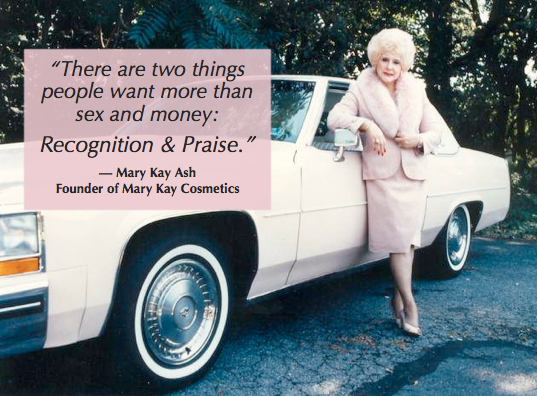
How you give praise matters
Knowing the importance of a positive praise to criticism ratio, your work is not done. How you given your praise is just as important to it having the desired effect.
When given correctly, praise can be a huge motivator. It can make people work harder and longer on their work, while applying themselves to grow. Done wrong, it can cause people to actually avoid new challenges and perform more poorly.
As psychologist and researcher Carol Dweck shows in this video below, praise directly impacts your mindset and work ethic:
Knowing all of this, the keys to using praise as an effective feedback tool involves a high frequency, a focus on effort and mindset (not "talent"), and being specific about what you want to see more of. By adding praise to your approach to improving your team's performance you also experience these benefits:
Positive:
- People are motivated to continue to improve if you keep noticing improvements in their areas of weakness. When they slip and they are not recognized, they will notice.
Anticipated:
- People look forward to praise, while often dreading criticism. Studies show the highest engagement comes when workers feel managers are genuinely interested in them; paying attention to their work enough to praise clearly demonstrates that interest.
Motivating:
- When you give effective praise, you will tap into the motivation and drive of your team. This is not always the case when you deliver critical feedback.
Even the most ambitious team members hungry for feedback appreciate praise and recognition for their work. As you look to improve certain areas of a team member's work, look for opportunities to praise that improvement and their effort to get there.
6) Ask questions to create feedback and self assessment
No one has all the answers. And since you can't see everything each person on your team does every moment of every day, questions are the best way to get the full picture. Asking good questions and listening intently are a critical part of leadership as SoulCycle's CEO Melanie Whelan emphasized in a NY Times interview:
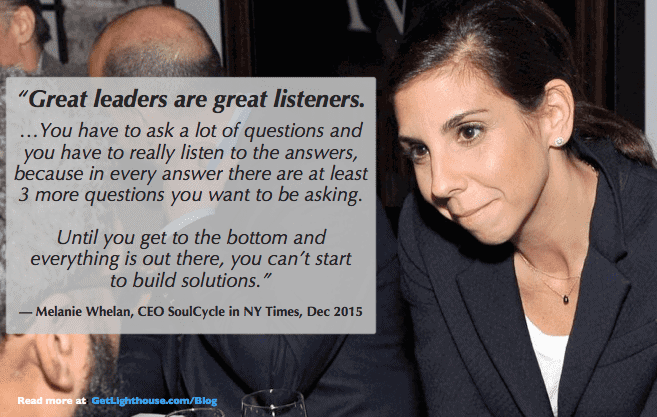
With the right context, you can not only create a great solution, you can also teach your team to have a critical eye to their own work. As you coach and develop your people to grow their Task Relevant Maturity, their eye for the difference between poor, good, and great work should improve.
As they show signs of mastery in their work, use more questions of them to create feedback. It will help develop their critical eye and make it easier for you to start managing them more hands-off in that area.
Kinds of questions to start a discussion:
- What went right with our last project? What should we repeat for next time?
- What could have gone better last project? What should we do differently? How can I help you?
- On a scale of 1-10, how would you rate your work on this project? What made it not a 10?
Using questions to involve your team members in your feedback process with them has many key benefits:
Independence:
- If your team learns to bring a critical eye to their own work, the bar is raised for everyone with less effort from you. If you have micro-management tendencies, this can help you feel more comfortable letting go, or at least partially stepping back.
Humility:
- By using questions, you show you don't have all the answers. It builds a greater level of trust and confidence in their abilities, while growing their skills in being their own critical eye on their work.
Scalable:
- There's only so much time in the day, and with all the meetings and other demands you face, you can't review everything. By teaching your team to question their work, it creates a more scalable solution to feedback.
Yes, you can take the questions too far, so don't make it an interrogation. Try to frame the discussion as an exploration of how things can be done better in the future, and you'll tap into some of the optimism found in Feed Forwards.
---
Conclusion:
There are many ways you can give feedback, but they're not all equally effective. While some, like the sh*t sandwich never really work that well, others are best used in certain situations.
Take these 6 tactics for giving feedback we shared today, and use them with your team to improve them in different situations. By mixing up your approaches, you'll find you always have a good way to deliver feedback to your team.
And if you want to learn more about how to give feedback, you can check out these posts here:
- Learn more about the Prepare - Listen - Act approach here.
- If you have a low-performing teammate, then check this instruction on how to deal with underperforming employees.
- Learn how to ask for feedback from your manager.
- Learn why real time feedback tools are a terrible idea for your company.
- And if you want to be a great manager, you also need feedback. Learn the ways to get feedback from employees.

How do you give feedback?
Giving good feedback comes from preparation and clear thinking. Your effort before giving the feedback, and the method you use is as important as what you want to share.
The simplest way is to remember 3 steps:
1. Prepare: Write out the issues you need to tell them about with specific examples and what the impact/consequences are.
2. Listen: Ask the person you're giving feedback how they're doing. Listen for any underlying issues.
3. Act: Set next steps and actions, so it's clear what needs to happen after you discuss the feedback with them.
Learn more about the Prepare-Listen-Act model and 5 other ways to give feedback here.
What is the meaning of giving feedback?
The meaning of giving feedback is to tell the other person where they can improve and the impact of the current way they're doing something. The goal is then for them to change for the better.
When you effectively give feedback, it will help the person recognize what they need to change and improve the situation for everyone involved. You can learn 6 ways to give great feedback that will have meaning and bring change here.
What are examples of positive feedback?
Positive feedback comes from being more forward looking and focusing on the change in the future instead of the problems in the past.
This process is known as a feed forward, which is one of 6 ways to give feedback you can learn about here.
How do I give feedback at work?
Giving good feedback at work comes from preparation and clear thinking. Your effort before giving the feedback, and the method you use is as important as what you want to share.
The simplest way is to remember 3 steps:
1. Prepare: Write out the issues you need to tell them about with specific examples and what the impact/consequences are.
2. Listen: Ask the person you're giving feedback how they're doing. Listen for any underlying issues.
3. Act: Set next steps and actions, so it's clear what needs to happen after you discuss the feedback with them.
Learn more about the Prepare-Listen-Act model and 5 other ways to give feedback here.





